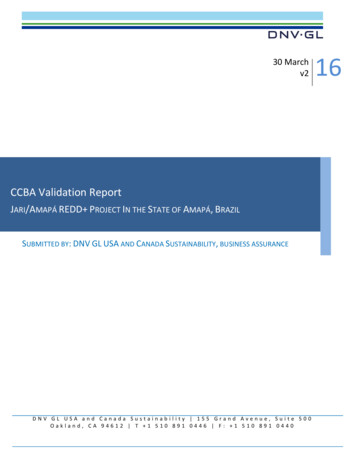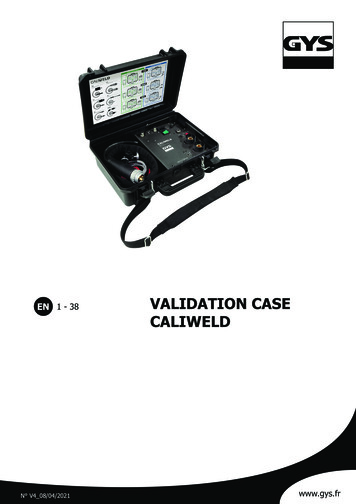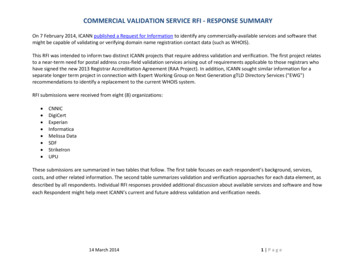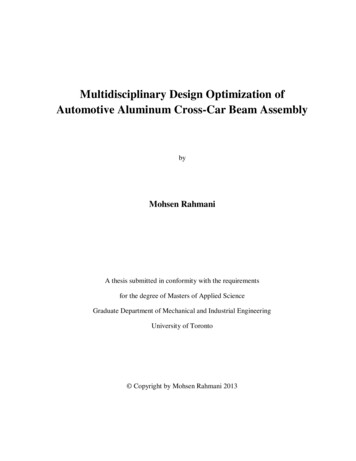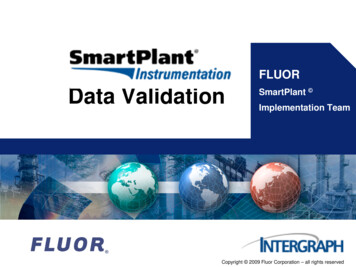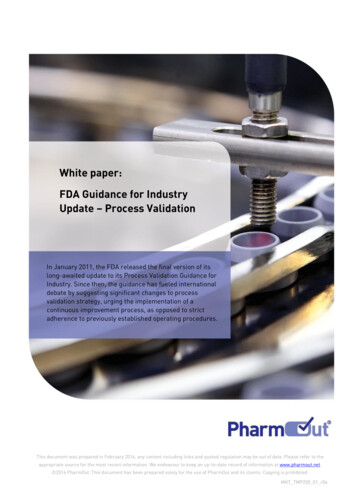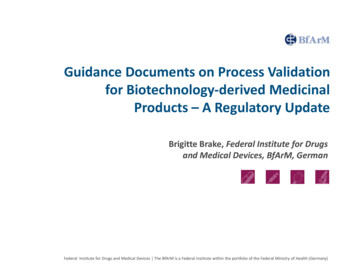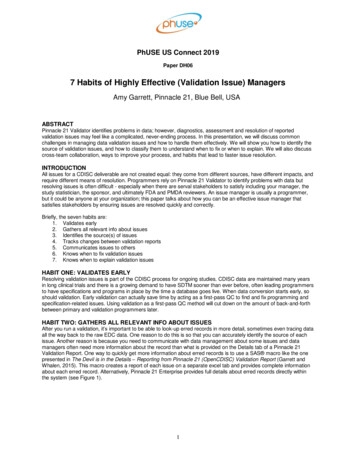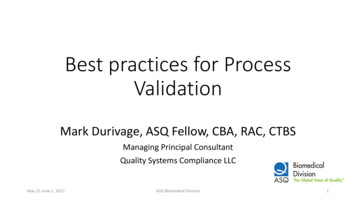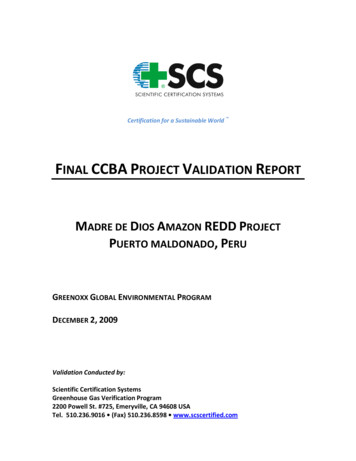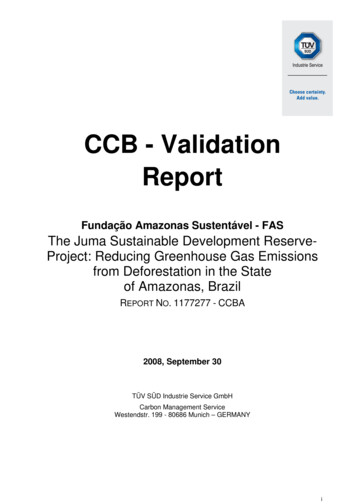
Transcription
CCB - ValidationReportFundação Amazonas Sustentável - FASThe Juma Sustainable Development ReserveProject: Reducing Greenhouse Gas Emissionsfrom Deforestation in the Stateof Amazonas, BrazilREPORT NO. 1177277 - CCBA2008, September 30TÜV SÜD Industrie Service GmbHCarbon Management ServiceWestendstr. 199 - 80686 Munich – GERMANYi
Validation of the CCBA Project:The Juma Sustainable Development Reserve Project: ReducingGreenhouse Gas Emissions from Deforestation in the State of Amazonas, Brazil.Report No.Date of first issueRevisionNo.Date of this revisionCertificate No.11772772008-9-30---Subject: Validation of a CCBA ProjectAccredited TÜV SÜD Unit:TÜV SÜD Contract Partner:TÜV SÜD Industrie Service GmbHCertification Body “climate and energy”Westendstr. 199 - 80686 MunichFederal Republic of Germany-Client:Project Site(s):Amazonas Sustainable FoundationRua Álvaro Braga, 351Parque 10 de Novembro, ManausAmazonas, BrazilProject Area as defined in PDDProject Title:The Juma Sustainable Development Reserve Project: Reducing Greenhouse GasEmissions from Deforestation in the State of Amazonas, Brazil.Applied Methodology / Version:none / project specificFirst PDD Version:Scope(s):14Final PDD version:Date of issuance:2008-07-05Date of issuance:2008-09-29Version No.:3Version No.:5Starting Date of GSP 2008-07-20Estimated Annual Emission Reduction:361,172 t tons CO2e (over first 10 years)Assessment Team Leader:Further Assessment Team Members:Martin SchröderGabriel MedinaSummary of the Validation Opinion:The review of the project design documentation and the subsequent follow-up interviewshave provided TÜV SÜD with sufficient evidence to determine the fulfilment of all statedcriteria. In our opinion, the project meets all relevant CCB requirements.The review of the project design documentation and the subsequent follow-up interviewshave not provided TÜV SÜD with sufficient evidence to determine the fulfilment of allrelevant CCB criteria.1
Validation of the CCBA Project:The Juma Sustainable Development Reserve Project: ReducingGreenhouse Gas Emissions from Deforestation in the State of Amazonas, Brazil.AbbreviationsCCB (A)Climate Community and Biodiversity (Alliance)ACMApproved Consolidated MethodologyAMApproved MethodologyCARCorrective Action RequestCDMClean Development MechanismCERCertified Emission ReductionCRClarification RequestDNADesignated National AuthorityDOEDesignated Operational EntityEBExecutive BoardEIA / EAEnvironmental Impact Assessment / Environmental AssessmentEREmission reductionGHGGreenhouse gas(es)GSPGlobal Stakeholder ProcessKPKyoto ProtocolMPMonitoring PlanNGONon Governmental OrganisationPDDProject Design DocumentPPProject ParticipantTÜV SÜDTÜV SÜD Industrie Service GmbHtCER / lCERtemporary CER; long-term CERUNFCCCUnited Nations Framework Convention on Climate ChangeVVMValidation and Verification Manual2
Validation of the CCBA Project:The Juma Sustainable Development Reserve Project: ReducingGreenhouse Gas Emissions from Deforestation in the State of Amazonas, Brazil.Table of ContentsPage1INTRODUCTION . 41.1Objective41.2Scope42METHODOLOGY . 62.1Appointment of the Assessment Team82.2Review of Documents82.3Follow-up Interviews92.4Resolution of Clarification and Corrective Action Requests102.5Internal Quality Control103SUMMARY OF FINDINGS . 114COMMENTS BY PARTIES, STAKEHOLDERS AND NGOS . 165VALIDATION OPINION . 17Annex 1: Validation ProtocolAnnex 2: Information Reference List3
Validation of the CCBA Project:The Juma Sustainable Development Reserve Project: ReducingGreenhouse Gas Emissions from Deforestation in the State of Amazonas, Brazil.1 INTRODUCTION1.1 ObjectiveThe validation objective is an independent assessment by a Third Party of the proposed project activity against all defined criteria as defined by the Climate Biodiversity and CommunityAlliance (CCBA).In line with the framework for the validation of a CDM project, corresponding tasks are carried by an Independent Operational Entity (DOE). TÜV SÜD is a DOE that is accredited byUNFCCC to validate AR-CDM projects. CCBA recognizes this AR-CDM accreditation.Validation will finally result in a conclusion by the executing DOE whether a project activity iscomplying with the CCB standards and whether this project should be submitted for registration with CCBA. The ultimate decision on the registration of a proposed project activity restswith CCBA .The project activity discussed by this validation report has been submitted under the projecttitle:The Juma Sustainable Development Reserve Project: Reducing Greenhouse Gas Emissionsfrom Deforestation in the State of Amazonas, Brazil.1.2 ScopeThe scope of any CCB assessment is defined by the underlying legislation, regulation andguidance given by relevant entities or authorities.For any CCB project activity the scope is set by:¾ CCB standards, in their most recent version, as published at www.climatestandards.org¾ Technical and methodological guidelines and information for best practice in landuse based mitigation projects¾ Internal and national standards on monitoring and QA/QC¾ The sectorial framework of the project (technical scope)In case of a CCB project that is also designed to comply with the requirements of an ARCDM project the scope includes furthermore the following:¾ The Kyoto Protocol, in particular § 12¾ Decision 2/CMP1 and Decision 3/CMP.1 (Marrakech Accords)¾ Further COP/MOP decisions with reference to the CDM¾ Decisions by the EB published under http://cdm.unfccc.int¾ Specific guidance by the EB published under http://cdm.unfccc.int4
Validation of the CCBA Project:The Juma Sustainable Development Reserve Project: ReducingGreenhouse Gas Emissions from Deforestation in the State of Amazonas, Brazil.¾ Guidelines for Completing the Project Design Document (CDM-PDD), and theProposed New Baseline and Monitoring Methodlogy (CDM-NM)¾ The applied approved AR CDM methodologyThe validation is not meant to provide any consulting towards the client. However, stated requests for clarifications and/or corrective actions may provide input for improvement of theproject design.Once TÜV SÜD receives a first PDD version, it is made publicly available on the internet atCCBA’s webpage for starting a 21 day global stakeholder consultation process (GSP). Incase of any request a PDD might be revised (under certain conditions the GSP will be repeated) and the final PDD will form the basis for the final evaluation as presented by this report. Information on the first and on the final PDD version is presented at page 1.The only purpose of a CCB validation is to indicate compliance with the CCBA standards andto use the corresponding reports during the registration process with CCBA. Hence, TÜVSÜD can not be held liable by any party for decisions made or not made based on the validation opinion.5
Validation of the CCBA Project:The Juma Sustainable Development Reserve Project: ReducingGreenhouse Gas Emissions from Deforestation in the State of Amazonas, Brazil.2 METHODOLOGYThe project assessment aims at being a risk based approach and is based on the methodology developed in the Validation and Verification Manual, an initiative of Designated and Applicant Entities, which aims to harmonize the approach and quality of all such assessments.In order to ensure transparency, a validation protocol was customised for the project. TÜVSÜD developed specific checklists and a protocol based on the templates presented by theValidation and Verification Manual. The protocol shows, in a transparent manner, criteria (requirements), the discussion of each criterion by the assessment team and the results fromvalidating the identified criteria. The validation protocol serves the following purposes: It organises, details and clarifies the requirements that a CCB project is expected tomeet; It ensures a transparent validation process where the validator will document how a particular requirement has been validated and the result of the validation.The validation protocol consists of several tables. The different columns in these tables aredescribed in the figure below.The completed validation protocol is enclosed in Annex 1 to this report.Validation Protocol Table 1: CCB - Conformity of Project ActivityChecklist Topic /QuestionReferenceCommentsConclusion onPDD in GSPFinal ConclusionThe checklist isorganised according to the sections of the CCBAstandards. Eachsection is thenfurthersubdivided. The lowest level constitutes a checklistquestion / criterion.Gives reference todocumentswhere theanswer tothe checklist questionor item isfound - incasethecommentreferstodocumentsother thanthe PDD orthe appliedmethodology.The section is used toelaborate and discuss thechecklist question and/orthe conformance to thequestion. It is further usedto explain the conclusionsreached. In some casessub-checklist are appliedindicating yes/no decisionson the compliance with thestated criterion. Any Request has to be substantiated within this columnConclusionsarepresented based onthe assessment ofthe first PDD version. This is eitheracceptable basedon evidence provided (;), or aCorrective ActionRequest(CAR)duetononcompliance with thechecklist question(See below). Clarification Request(CR) is used whenthe validation teamhas identified aneed for furtherclarification.Conclusionsarepresented in thesamemannerbased on the assessment of thefinal PDD and otherbackground documentation version.6
Validation of the CCBA Project:The Juma Sustainable Development Reserve Project: ReducingGreenhouse Gas Emissions from Deforestation in the State of Amazonas, Brazil.Validation Protocol Table 2: CCB - Resolution of Corrective Action and Clarification RequestsClarifications and corrective action requestsRef. to table 1Summary of projectowner responseValidation team conclusionIf the conclusions fromtable 1 are either a Corrective Action Requestor a Clarification Request, these should belisted in this section.Reference to thechecklistquestionnumber in Table 1where the CorrectiveAction Request orClarification Requestis explained.The responses givenby the client or otherprojectparticipantsduring the communications with the validation team should besummarised in thissection.This section should summarisethevalidationteam’s responses and finalconclusions. The conclusions should also be included in Table 1, under“Final PDD”.In case that the CCBA project activity undergoes simultaneously a CDM validation, the corresponding CDM validation protocol will be attached in order to provide the complete andconsistent set of considered criteria.In these cases, the content of Annex 1 will be structured as follows: Validation Protocol Table 1a): CCB - Conformity of Project Activity Validation Protocol Table 1b): CDM - Conformity of Project Activity Validation Protocol Table 2a): CCB - Resolution of Corrective Action and ClarificationRequests Validation Protocol Table 2b): CDM - Resolution of Corrective Action and ClarificationRequestsIn case of a denial of the project activity more detailed information on this decision will bepresented in table 3.Validation Protocol Table 3: Unresolved Corrective Action and Clarification RequestsClarifications and corrective action requestsId. of CAR/CR 1Explanation of the Conclusion for DenialIf the final conclusionsfrom table 2 results in adenial the referencedrequest should be listedin this section.Identifier of the Request.This section should present a detail explanation, whythe project is finally considered not to be in compliance with a criterion.7
Validation of the CCBA Project:The Juma Sustainable Development Reserve Project: ReducingGreenhouse Gas Emissions from Deforestation in the State of Amazonas, Brazil.2.1 Appointment of the Assessment TeamAccording to the technical scopes and experiences in the sectoral or national environmentTÜV SÜD has composed a project team in accordance with the appointment rules of theTÜV SÜD Certification Body “climate and energy”. The composition of an assessment teamhas to be approved by the Certification Body ensuring that the required skills are covered bythe team. The Certification Body operates four qualification levels for team members that areassigned by formal appointment rules:¾ Assessment Team Leader (ATL)¾ Greenhouse Gas Auditor (GHG-A)¾ Greenhouse Gas Auditor Trainee (T)¾ Experts (E)It is required that the sectoral scope linked to the methodology has to be covered by the assessment team.The validation team was consisting of the following experts (the responsible AssessmentTeam Leader in written in bold letters):NameMartin SchröderGabriel MedinaQualificationCoverageof technicalscopeCoverageof sectoralexpertiseHost country experienceATL;;;E;;;Martin Schröder is appointed as Assessment Team Leader by the certifcation body "climateand energy" of TÜV SÜD. He holds a masters degree in tropical forest science. Within TÜVSÜD he is responsible for the validation and verification of forestry based greenhouse gasmitigation projects. He passed successfully internal training schemes in the field of auditing.Before entering the company, he worked on development projects in the Amazon Regionand managed voluntary carbon offset projects.Gabriel Medina is appointed as Forestry Expert by the certifcation body "climate andenergy" of TÜV SÜD. Mr. Medina is based in Belem, Brazil and works with a focus on forestry projects. He holds a Phd title in the field of community forestry and development projects. In the context of the present audit he provided expertise on the national frameworkrelevant for reforestation and forest conservation projects.2.2 Review of DocumentsThe first PDD version submitted by the client and additional background documents relatedto the project design and baseline were reviewed as initial step of the validation process.8
Validation of the CCBA Project:The Juma Sustainable Development Reserve Project: ReducingGreenhouse Gas Emissions from Deforestation in the State of Amazonas, Brazil.A complete list of all documents and proofs reviewed is attached as annex 2 to this report.2.3 Follow-up Interviews and visited sitesIn the period of July. 24 to 31, 2008 TÜV SÜD performed interviews on-site with projectstakeholders to confirm selected information. The table below provides a list of all personsinterviewed in the context of this on-site visit.NameOrganisationBritaldo Soares FilhoProfessor / UFMGLucio PedroniConsultant / Carbon DecisionsMariano CenamoIDESAMGarbriel RibenboimProject Manager / FASVirgilio VianaDirector General / FASLuiz C. ViallaresDirector Financial Dep. / FASRaquel LunaFASJoáo Tezza NetoGIS unit / FASGabriel C. CarreroIDESAM / INPAGustavo A ReginatoIDESAMMariana Noguiera PavanIDESAMRomulo F. BatistaConsultantDomingos MacedoCEUC / SDSMarina T CamposCECCLIMA / SDSNadia FerreiraDirector / SDSDenis MinevSecretario / SEPLANPhilip M. FernsideResearcher / INPANiro HiguchiResearcher / INPAFurthermore numerous local inhabitants of communities were interviewed. Due to the largenumber of participants, only the name of presidents of the community visited are given:Boa Frente – President / José Marlos AjunarCom. Primavera - President / Claudes Braga PaulaSan Francisco – community members were internviewed9
Validation of the CCBA Project:The Juma Sustainable Development Reserve Project: ReducingGreenhouse Gas Emissions from Deforestation in the State of Amazonas, Brazil.In the context of the onsite visit, the project area due to be protected has been visited. Fieldtrips to confirm baseline conditions in the large project area were carried out by car, boat andplane.In first insitance the areas were visited by travelling on the only intersecting road. Then oneof the main rivers was passed on with boat, visiting a selection of the communities at the rivershore. Last but not least, it was navigated to a set of preselected GPS points with a smallplane – principally to confirm land use classification.2.4 Resolution of Clarification and Corrective Action RequestsThe objective of this phase of the validation is to resolve the requests for corrective actionsand clarifications and any other outstanding issues which needed to be clarified for TÜVSÜD s positive conclusion on the project design. The Corrective Action Requests and Clarification Requests raised by TÜV SÜD were resolved during communication between the clientand TÜV SÜD.To guarantee the transparency of the validation process, the concerns raised and responsesthat have been given are summarised in Chapter 3 below and documented in more detail inthe validation protocol in Annex 1.2.5 Internal Quality ControlAs final step of a validation the report and the protocol have to undergo and internal qualitycontrol procedure by the Certification Body “climate and energy”, i.e. each report has to beapproved either by the Head of the certification body or his Deputy. In case one of these twopersons is part of the assessment team approval can only be given by the other one.In the current case, quality control has been further more supported by Dr. Hubertus Schmidtke, who is an appointed forestry auditor on behalf of the Certification Body “climate and energy”.It rests at the decision of TÜV SÜD’s Certification Body whether a project will be submittedfor registration with CCBA.10
Validation of the CCBA Project:The Juma Sustainable Development Reserve Project: ReducingGreenhouse Gas Emissions from Deforestation in the State of Amazonas, Brazil.3 SUMMARY OF FINDINGSAs informed in previous chapters above, all finding are summarized in Table 2 of the attached validation protocol. In total the assessment team issued 31 Clarification Requests and32 Corrective Action Requests.This large number of Requests is partially explained by the fact that projects which focus onreducing emissions from avoided deforestation do not have an approved baseline and monitoring methodology available.Key Requests for Clarification and Corrective Action were related to the project’s baselinedeforestation rates, the scheduled activities as well as project additionality. Furthermore itwas focussed on the consistency of the monitoring plan in regard to main parameters. In regard to CCBA specific requirements it was requested, among others, that further informationon net project effects and conflict management procedures were elaborated.In regard to these Requests for Clarification further information and additional documentshave been requested whenever the submitted documents did not allow a judgement of corresponding criteria. Based on this additional information all Requests for Clarification havebeen answered sufficiently. Only in regard to the leakage assessment and a necessary approval a Forward Action Request was posed, which is to be revisited at verification.Forward Action Request 1:The geographic limits of a leakage belt remain to be confirmed. The methodological approach of factoring out regular migration / deforestation from project related migration / deforestation remains, i.e. as part of an approved VCS methodology.Forward Action Request 2:Approval of the project as defined per PDD by the Juma Reserve Council to be revisited atverification.Other main findings on the project are the following:Project areaThe project with an area of 472,677 ha is located south of Manaus in the State of Amazonas.The project area is fully covered with native tropical forests. In order to assure consistencyfor the baseline estimates and later monitoring, intervened areas as well as other areas without forest cover have been excluded through satellite image based mapping exercises. Partially the exclusion of non-forest areas was triggered through the audit. The audit team requested that changes to the boundary shall be monitored. The entire project area is part ofthe Juma Reserve, a protected area installed by the State of Amazonas. As indicated above,all non forest areas within the Reserve (community areas, areas with land claims, roads, rivers etc) have been excluded from the project area.It has been documented and sustained with evidence that the area of the Reserve is in stateownership and that FAS may be authorized by the Executive Power to commercialize environmental services. Based on this mandate, an agreement on the project and the merchan11
Validation of the CCBA Project:The Juma Sustainable Development Reserve Project: ReducingGreenhouse Gas Emissions from Deforestation in the State of Amazonas, Brazil.dising of carbon benefits has been signed by FAS and the Governor as well as the projectsponsor. Therefore it is concluded, that at validation the contractual context is sufficiently defined.While it is recognized that CCBA does not foresee the issuance of carbon credits, further legal analysis is considered necessary in regard to the interaction with evolving Brazilian federal legislation in case that Brazil assumes a national emission reduction target which mayinclude the accounting for domestic land use activities.Due to the latter and in order to reflect on the possibility of land property changes or claims,the audit team requested that the continued access to carbon rights from the project shall bemonitored over implementation time.BaselineFor the above indicated project boundary, the different forest types have been identifiedthrough a mapping process. The underlying carbon densities per forest type have been takenfrom credible literature sources which summarize studies that were compiled in the actualproject region. Total carbon stocks for all biomass pools (with exception to soil organic carbon) have been estimated to be 156-161 t C / ha for the classes Alluvial Forest and DenseForest.It was noted that the project has opted to implement an initial forest inventory (after validation), which is scheduled to generate more precise data on the carbon densities present inthe project area. This inventory is to be finalized before the first verification. While recognizing the relevance of the current literature based data used, the audit team considers this approach designed to generate project specific data sets as very capable to improve the overallquality of the baseline assessment. This leads to the fact that the considered baseline emissions may change to some extent at the first verification.The actually expected deforestation for the project area under the baseline scenario hasbeen another core element used for the estimates of the expected emission reductions. Thesoftware tool SimAmazonia has been applied for the modelling of the expected deforestation.Among others, the model and its functionality was documented in peer reviewed publications. Central input parameters, i.e. deforestation rates, and drivers, i.e. scheduled road construction, have been reviewed separately and were sustained with evidence. In light of theconfirmation of core assumptions contained in the model and the fact that the model hasbeen developed for the Amazon region, SimAmzonia is considered to be an adequate modelling tool for the project context. From the available scenarios that are part of the model, ascenario was selected that did not include changes in governance or the creation of additional protected areas. This is considered conisistent with the approach that the creation ofthe protected areas (posterior to 2003) is already part of a larger programmatic approach.CDM guidance on the consideration of policy changes posterior to 2001 (which reduce emissions) is also considered relevant (EB 22) in this context.On the technical level, individual GIS layers were generated for each year of deforestation(by SimAmzonia) and then overlaid with the initial forest cover map. Based on this the yearlydeforestation rates per forest type were elaborated. Corresponding processing has beendocumented.The expected baseline emissions have been estimated through the multiplication of yearlydeforestation rates with the difference between the initial carbon density (prior to deforestation) and the remaining carbon density (after deforestation) for each forest type. Remaining12
Validation of the CCBA Project:The Juma Sustainable Development Reserve Project: ReducingGreenhouse Gas Emissions from Deforestation in the State of Amazonas, Brazil.carbon densities are taken from a regional study on this matter and are considered conservative literature based estimates.Under the described baseline scenario it is assumed that further emission of non-CO2 emissions emerge by the burning of deforestation areas. Burning is a documented common practice in the context of land use changes in the Brazilian Amazon region. A credible literaturebased emission factors for non-CO2 emissions was applied.In regard to biodiversity and social aspects, an abundant assessment carried out in the context of the creation of the Juma Reserve has been the main source for the definition of theinitial project conditions in these fields. The provided information is considered to constitute asufficient starting point for further monitoring.Ex-ante emission reductions (and net effects)The expected emission reductions are calculated by the above described estimates on thebaseline emissions. A discount of 10 % (on the modelled deforestation) was considered inorder to reflect on the fact that the project activities may not be able to stop deforestationcompletely.Cumulated emission reductions until year 10 of implementation (2016) are expected to be3.764.564 t CO2 due to avoided stock changes and an additional 248.461 t CO2-e fromavoided burning, totalling to 4,013,025 t CO2-e. The project opted to include a further discountof 10 % in order to reflect on overall risks and further leakage assessment (401,302 t CO2-e).Up to the year 2016 when the baseline is to be revised, the expected emission reductionsare quantified with 3,611,723 t CO2-e. It is considered credible that potential leakage, i.e. dueto deforestation by settlers that move out of the Reserve, is going to be sufficiently coveredby this buffer (see comments below on monitoring).Thus, the given estimations are considered to be sufficiently substantiated by verified dataand assumptions.It is underlined that the risk assessment according to VCS requirements (as basis for permanence buffer) has not been part of the scope of this CCBA audit.In the field of biodiversity and social aspects, the project is considered to generate net positive impacts. On the social side it has been noted that continued information and on the project programmes that are designed to generate additional and partially alternative (to woodharvesting) income to the local population is of elevated relevance.AdditionalityThe creation of the Juma Reserve in 2006 has been the reference for the definition of thestarting date of this project.The Juma Reserve is embedded to an initiative on the expansion of protected areas, whichshows characteristics of a programme of activities (if i.e. compared to the CDM mechanismof the Kyoto Protocol). As a result of this initiative the State of Amazon has increased theProtected Areas of the State by almost 10 million ha during the years 2003-2007 (up to a total of 17 million ha). This expansion is not considered part of the baseline (compare above).It was documented and sustained with evidence that the commercialisation of environmentalservices, including carbon credits, has been the intention since the start of this initiative onthe increase of protected areas (and with that prior to the date of creation of the Juma Reserve). The underlying state programme “Green Free Trade Zone” and the subsequent series of events (i.e. in the international climate change arena where this approach was pro13
Validation of the CCBA Project:The Juma Sustainable Development Reserve Project: ReducingGreenhouse Gas Emissions from Deforestation in the State of Amazonas, Brazil.moted) have been documented. The final PDD (i.e. pp 157-166; 169) includes an overview ofmeasures part of this de facto programmatic but project based REDD approach.It was furthermore analyzed that the typical funding provided to the State’s protected areas intimes prior to 2003 were not sufficient to assure an effective protection. It was analyzed thataverage funding in these times (prior to the start of the programme) has not been significant,also i.e. in comparison to the scheduled expenditures of the project. At the point of validation,the institutions involved (SDS / IPAAM) underlined and documented that were no other statefunds pledged to conservation measures in the Reserve.In light of the latter the audit team concluded that the creation of the Juma Reserve and theproject’s measures of conservation and development do not represent the business as usualscenario. The project activities are considered additional.MonitoringCore elements of monitoring, also in regard to biodiversity and social components, havebeen included to initial monitoring plans that are made part of the PDD. All key parameterswere considered (i.e. on stock changes in different pools, land use changes posterior to project start etc). Nonetheless the definition of operational procedures i.e. on the monitoring offire events remains to be further specified in the course of implementation and prior to thefirst verification. This also includes the concrete calculation approaches and the consideration of uncertainties in measurements.It was noted that the project foresees a specification of the baseline carbon densities throughan inventory in the pristine forest areas. The relevance of the chosen source on carbon densities in typical non-forest classes
CCBA's webpage for starting a 21 day global stakeholder consultation process (GSP). In case of any request a PDD might be revised (under certain conditions the GSP will be re-peated) and the final PDD will form the basis for the final evaluation as presented by this re-port. Information on the first and on the final PDD version is presented .
